Cosmic Enigmas Unveiled
© NASA/JPL-Caltech
Table of Contents
A black hole is a region in spacetime where gravity is so intense that not even light or any other electromagnetic waves can escape. According to the theory of general relativity, a mass compacted sufficiently can warp spacetime to create a black hole, with the point of no return known as the event horizon.
The demise of a massive star gives rise to a stellar-mass black hole. When such a star depletes its nuclear fuel, its core destabilizes and implodes under gravity, while the outer layers are expelled. The collapsing core, under immense pressure, compresses to a point of infinite density called the singularity. Only stars over three solar masses culminate as black holes. Stars with less mass become either white dwarf stars or neutron stars.
Some have origins unrelated to stars. Astronomers hypothesize that vast quantities of interstellar gas accumulate and collapse into supermassive black holes at the cores of galaxies and quasars. The process of rapid gas infall into it is estimated to release over 100 times the energy generated by an equal mass through nuclear fusion. This could explain the immense energy emitted by quasars and specific galactic systems, arising from the gravitational collapse of millions or billions of solar masses of interstellar gas.
Detecting these cosmic mysteries is challenging due to their size and lack of visible light emissions. Instead, their presence is inferred from the gravitational effects on nearby matter. For instance, if a black hole is part of a binary star system, the matter flowing into it from its companion becomes intensely heated, emitting copious X-rays before vanishing beyond the event horizon forever.
FORMATION
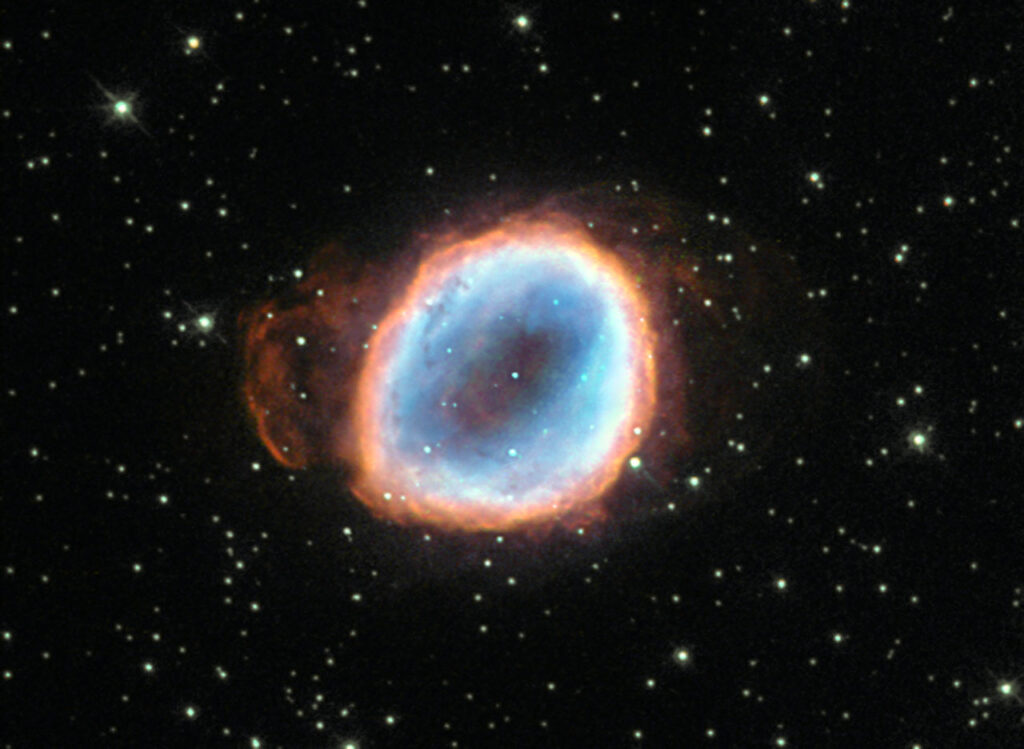
Black holes are born from the dramatic demise of massive stars. When such a star exhausts its nuclear fuel, it undergoes a cataclysmic collapse. This gravitational implosion creates an infinitely dense core known as a singularity, surrounded by an event horizon from which nothing, not even light, can escape.
STELLAR EVOLUTION
Stellar evolution is the process by which a star undergoes stages of transformation over its lifespan, determined by its initial mass. It begins within a nebula, where gravity prompts the formation of a protostar. As the protostar accumulates mass, it enters the main sequence phase, where hydrogen fusion generates energy. When hydrogen depletes, the star expands into a red giant or supergiant, depending on its size. In the core, helium fusion ensues, forming heavier elements. The eventual fate of a star depends on its mass; smaller stars become white dwarf stars, while more massive ones can culminate in supernovae and neutron stars or black holes.
SUPERNOVA EXPLOSION
A supernova explosion is a cataclysmic event in the life cycle of a massive star. When the star’s core can no longer withstand the force of gravity, it undergoes a rapid and violent collapse. This collapse releases an enormous amount of energy, causing a powerful explosion. The outer layers of the star are expelled into space, creating a brilliant burst of light and radiation. Supernovae are among the most energetic events in the universe, and they play a crucial role in dispersing heavy elements and triggering the formation of new stars and planetary systems.
FORMATION OF NEUTRON
Following a massive star’s core collapse, two possible outcomes emerge. For stars below a certain mass threshold, around 2.5 to 3 times that of our Sun, the core contracts into an incredibly dense object called a neutron star. This densely packed remnant consists almost entirely of neutrons.
In contrast, if the core’s mass exceeds this threshold, gravitational forces persist, leading to further collapse. This culminates in the formation of a black hole. Within the core lies a point of infinite density and gravity called a singularity, shrouded by the event horizon, a boundary beyond which nothing, not even light, can escape. This process marks the birth of the cosmic enigma.
GRAVITATIONAL SINGULARITY
A gravitational singularity is an extraordinary theoretical concept at the heart of a black hole. It represents an infinitely small, dense point where the laws of physics as we understand them no longer apply. Within a black hole, this singularity exerts an unimaginable gravitational pull, warping spacetime to an extreme degree.
EVENT HORIZON
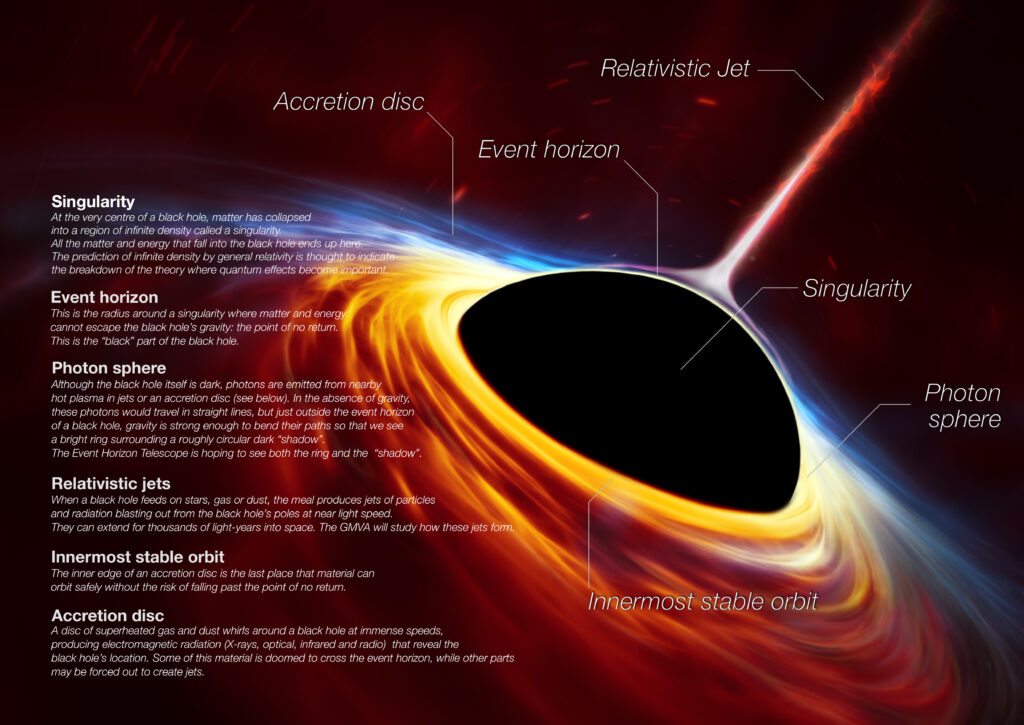
The event horizon is a defining feature, marking the boundary beyond which escape is impossible, even for light.
FORMATION
The event horizon originates from the gravitational collapse of a massive star’s core. As the core contracts under its own gravity, it reaches a point of no return, where escape velocity exceeds the speed of light. The event horizon is synonymous with the Schwarzschild radius, a theoretical boundary surrounding a non-rotating (or spherically symmetric) black hole. Within this radius, the gravitational pull is so intense that not even light can break free.
CHARACTERISTICS
INVISIBILITY
The event horizon is a theoretical boundary and does not have a tangible surface. It is an imaginary surface that defines the region from which no information or radiation can escape.
SIZE AND PROPORTIONS
The event horizon’s dimensions hinge on the black hole’s mass. For instance, a black hole equivalent to our Sun in mass would possess a radius of approximately 3 kilometers (1.9 miles).
SIGNIFICANCE
The material falling toward a black hole but outside the event horizon forms an accretion disk. As it spirals inward, it releases energy in various forms, including X-rays.
Although the event horizon itself cannot be directly observed, scientists can study the effects of its presence on surrounding matter and detect the emissions from nearby regions.
SINGULARITIES
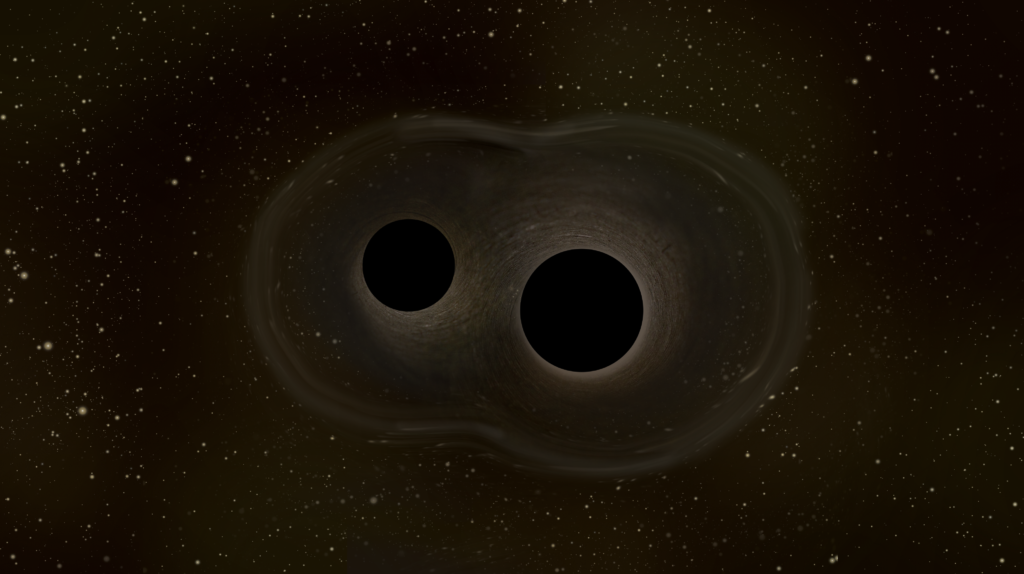
The singularities within black holes are some of the most enigmatic and mind-bending aspects of the universe. They are points of infinite density and gravitational force, where our current understanding of physics breaks down.
FORMATION
Singularities result from the gravitational collapse of a massive star’s core. As the core contracts under its own gravity, it reaches a critical point where further compression is inevitable. Within a black hole’s core lies the singularity—a point of infinite density. This means that the mass of the star is concentrated within an infinitely small space. As a result, spacetime curvature becomes infinitely severe, creating a region where the laws of physics, as we know them, no longer apply.
TYPES
POINT SINGULARITY
The most commonly discussed type is the point singularity, where all the mass is concentrated at a single, infinitely dense point. This concept is a prediction of general relativity.
RING SINGULARITY
In some theoretical models, especially involving rotating black holes, the singularity may take the form of a rotating ring instead of a point. This adds further complexity to the nature of singularities.
Singularities bring together the realms of general relativity (describing gravity on cosmic scales) and quantum mechanics (governing the behaviour of particles on the smallest scales). Understanding how these two theories reconcile within a singularity is one of the greatest challenges in theoretical physics.
ACCRETION DISK
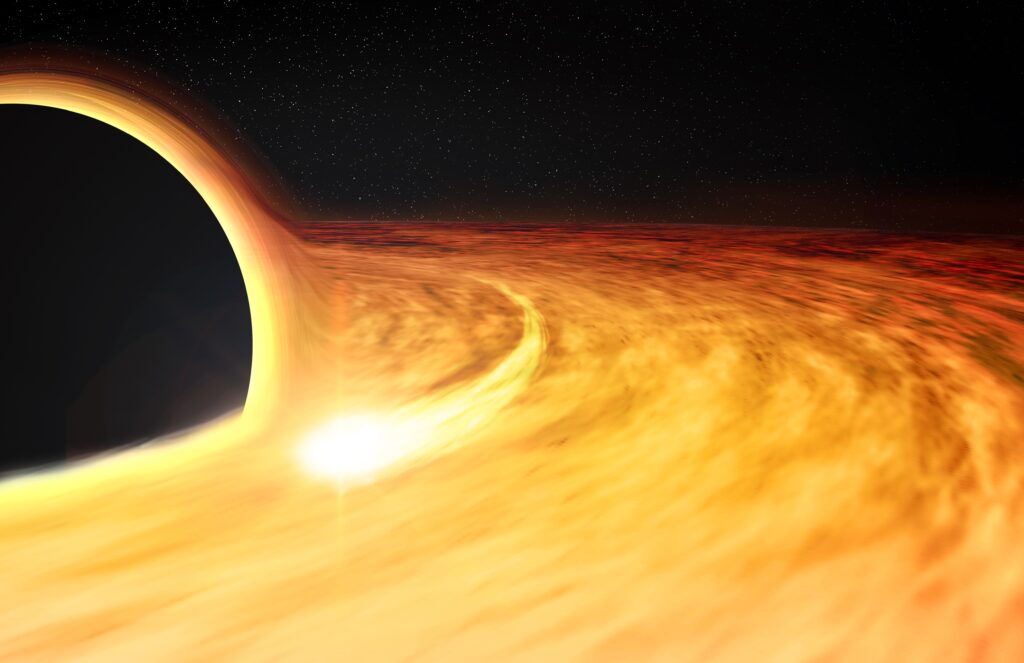
Accretion disks are fascinating cosmic structures that form around black holes and other massive celestial objects. These disks consist of gas, dust, and other matter swirling in a flat, rotating plane, drawn in by the immense gravitational pull of the central object.
FORMATION
The strong gravitational field of a black hole exerts a powerful force on nearby matter, drawing it in from the surrounding space. As the matter approaches the black hole, it doesn’t fall directly in. Instead, it forms a disk-like structure due to the conservation of angular momentum. This causes it to spiral inward, akin to water spiralling down a drain.
Accretion disks are composed of various materials, including gas (mostly hydrogen and helium), dust particles, and occasionally heavier elements. These components can reach incredibly high temperatures and pressures as they near the black hole.
CHARACTERISTICS
INTENSE RADIATION
The matter in an accretion disk is subject to extreme conditions, leading to the emission of intense radiation across the electromagnetic spectrum, from X-rays to radio waves.
ENERGETIC PROCESSES
Friction and magnetic fields within the disk drive complex physical processes. As matter collides and interacts, it generates immense heat and pressure, resulting in the emission of radiation.
RELATIVISTIC JET

Relativistic jets are some of the most energetic and awe-inspiring phenomena in the universe. They emanate from the vicinity of black holes, particularly those with rapidly spinning accretion disks. These jets are high-speed streams of charged particles accelerated to nearly the speed of light.
FORMATION
Within the accretion disk surrounding a black hole, magnetic fields play a crucial role in the acceleration and ejection of particles. As matter spirals inward towards the black hole, some of it gets caught in the strong magnetic fields, undergoing processes that lead to the expulsion of particles along the polar regions. Close to the event horizon, the intense gravitational fields and magnetic forces accelerate charged particles, propelling them away from the black hole at velocities approaching the speed of light.
CHARACTERISTICS
NEAR-LIGHT SPEED
Relativistic jets are composed of particles, such as electrons and protons, moving at velocities very close to the speed of light. This incredible speed is a hallmark of these structures.
COLLIMATED BEAMS
These jets are highly collimated, meaning they maintain a focused and narrow trajectory over vast distances, often spanning thousands of light-years.
EMISSION ACROSS THE SPECTRUM
Relativistic jets emit radiation across a wide range of wavelengths, from radio waves to gamma rays, making them observable using various telescopes and instruments.
PHOTON SPHERE
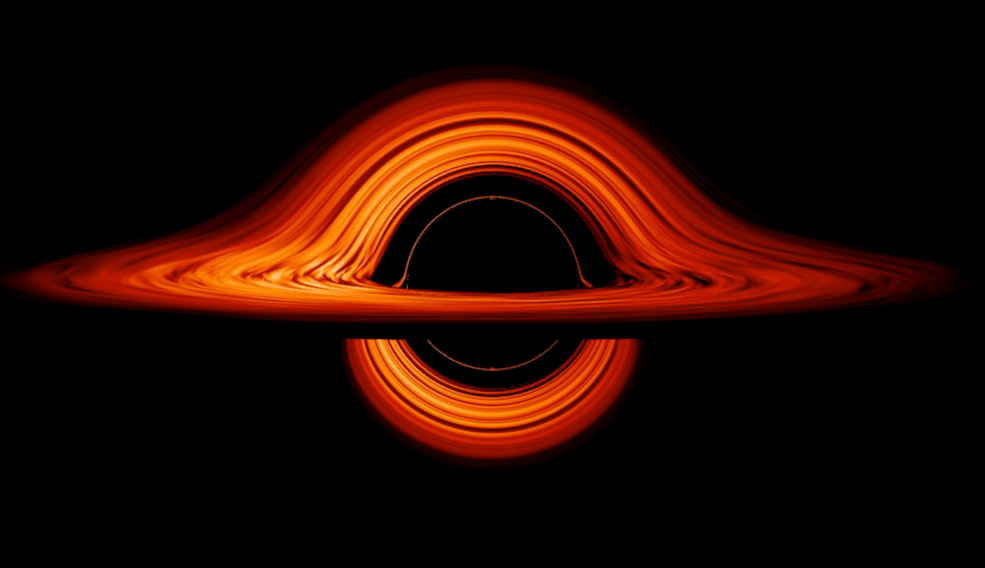
The photon sphere is a region in the vicinity of a black hole where gravity is so strong that photons—particles of light—can travel in stable orbits. This phenomenon is a consequence of the profound warping of spacetime caused by the immense gravitational pull of the black hole.
FORMATION
Due to the intense gravitational field of a black hole, spacetime is severely distorted. Light rays, passing close to the black hole, are bent, resulting in a region where photons can orbit the black hole. Within the photon sphere, photons can theoretically orbit the black hole in stable, closed trajectories. However, these orbits are inherently unstable, meaning any perturbation can cause the photon to either escape or plunge into the black hole.
CHARACTERISTICS
RADIUS AND DISTINCTIVENESS
The photon sphere lies at a specific radius from the black hole, known as the “photon radius.” This radius is approximately 1.5 times the Schwarzschild radius (the event horizon’s radius in non-rotating black holes).
NO SURFACE
The photon sphere does not have a physical surface or substance; it is a region defined by the properties of the spacetime curvature around the black hole.
GRAVITATIONAL REDSHIFT
Photons orbiting in the photon sphere experience extreme gravitational redshift. This means that when observed from a distant location, the light appears highly redshifted, indicating the strong influence of gravity.
TYPES OF BLACK HOLES
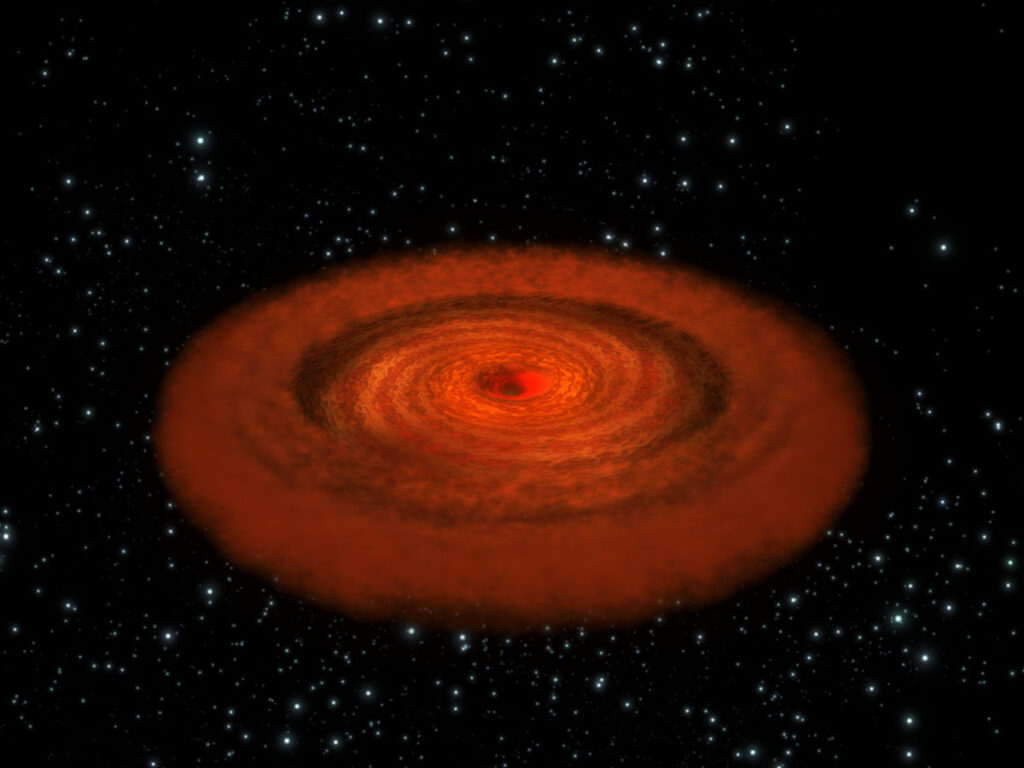
Black holes come in various forms, each distinguished by its mass, rotation, and electric charge.
STELLAR
These are the most common type of black holes, formed from the gravitational collapse of massive stars. When a star’s core exceeds a certain mass threshold (around 2.5 to 3 times that of the Sun), it collapses under its own gravity. Stellar black holes typically have a mass ranging from a few to several tens of times that of the Sun. They are characterized by their relatively smaller size compared to supermassive black holes and are found scattered throughout galaxies.
SUPERMASSIVE
These colossal black holes are located at the centers of galaxies, including our Milky Way. Their origins remain a subject of ongoing research, possibly arising from the accretion of immense amounts of matter or the merging of smaller black holes. Supermassive black holes have masses ranging from millions to billions of times that of the Sun. They exert a profound influence on galactic dynamics and play a pivotal role in the formation and evolution of galaxies.
INTERMEDIATE MASS
These black holes are hypothesized to occupy the intermediate range between stellar and supermassive black holes. Their formation mechanisms are uncertain, potentially arising from the merger of smaller black holes or through other processes.
PRIMORDIAL
These are hypothetical black holes that might have formed in the early universe, potentially from fluctuations in the density of matter during the Big Bang. Detecting primordial black holes is exceptionally challenging, and their existence remains a topic of theoretical investigation.
ROTATING (KERR)
These black holes possess angular momentum due to the rotation of the star from which they formed. As a result, they exhibit distinctive features like an ergosphere and a ring singularity.
CHARGED (REISSNER-NORDSTROM)
These black holes carry an electric charge, which affects their structure and behaviour. However, they are considered to be less likely to exist in nature.
Black holes, cosmic enigmas born from stellar collapse, are among the universe’s most intriguing phenomena. Defined by their event horizons and singularities, they challenge the boundaries of our understanding. From stellar to supermassive giants at galactic cores, they shape the cosmos. Stephen Hawking’s groundbreaking theory of Hawking radiation added a new layer to their complexity. As science advances, so does our grasp on these cosmic mysteries.
